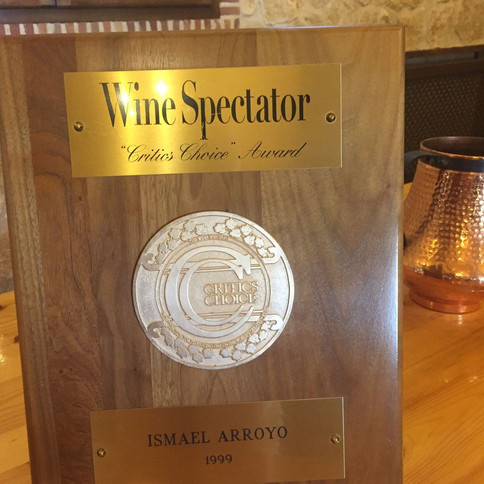Valsotillo - Trip Report - June 2019
- Ricardo Llovet
- Sep 15, 2019
- 5 min read
Updated: Dec 22, 2021
Some say that Ribera del Duero is the best wine region in Spain. Certainly a worthwhile rival to the far better known Rioja. You may encounter many “wine experts” in our state that have never tried it, or may barely know about its existence. Its predominant varietal is the same as in Rioja, but in sharp contrast with Rioja’s light color and silky palate, Riberas are dark and astringent. Powerful. Many are big wines. Rioja looks for refinement while Ribera looks for boldness!
Wine was produced in the banks of the Duero river by the Vaecos Celtiberian tribe 500 years BC, and the Romans continued and expanded its consumption. During our visit to Valsotillo, Miguel Angel Arroyo, the co-owner, explained that during the Napoleonic wars the French invaders imposed a tax on the villagers of Sotillo de la Ribera the town where Valsotillo is located, "to be paid in barrels of wine"!.
The region is located in North-central Spain, two hours North of Madrid, in Castilla Leon’s plateau at average elevations of 2,250 – 2,550 ft (750 m. – 850 m.). It is densely populated by vineyards and dotted with medieval towns and castles, and it flows along the Duero river. This is the same river as Douro in Portugal whose fruits produce Port wines.

We chose a beautiful and sunny day in June for our trip and could appreciate the effect of the Spring rains in the otherwise semi-arid landscape:

The queen of the varietals here is Tinta del País (the local name of Tempranillo). Some bodegas have planted Cabernet Sauvignon and Merlot and are adding them as minoritary components of the blend to give the wines a more international palate, but others, like Valsotillo, remain loyal to tradition and only use Tempranillo. In fact, everything about Valsotillo is tradition and traditional. And that is why I consider it a gem that must be preserved and revered.
See below the fachade of the bodega and a view of Sotillo de la Ribera from tits esplanade.
This was mi third visit to Valsotillo. When we were living in Spain, Sally became dear friends with Marga, Jesús’ wife. Jesús was Miguel Angel’s first cousin. Marga and Jesus ended up living in the same apartment building as my sister Begoña and her husband Alessandro. Our first two visits to the bodega remain fond in our memories. First for the surprise and novelty, second for the camaraderie, and third for the suckling lamb grilled in vine shoots campfire. We also visited a free range sheep operation from another Jesus’ cousin and a sheep cheese factory. Quite a rural economy experience.
This time the Sommeliers were my brother, Juancho, one of the best wine tasters in Spain, and his brother in law Juan, a university professor from Burgos, the capital town of the province. And since the visit was planned in the early afternoon, we started with a late lunch.

We tasted several wines during this lunch but we will talk about them at the end of the report. Now let’s go with Miguel Angel for a walk:
The soil has a prevalence of clay mixed with stones and marl. Laderas (slopes) are best, with good drainage and sun exposure. The vines are grown in vase and with significant separation, There is no much water in here. The harvest is performed manually.

Valsotillo owns 7 properties and produces a good part of its grapes. The rest is sourced from growers that have been providing their fruits to the bodega for decades. The vines are an average of 40 years old with some up to 90 years old. All Tempranillo. In the 80’s many were pulling vines in the region, but Ismael Arroyo, Miguel Angel’s father, kept planting. Some said he was crazy but now they are biting their tongues and doing the planting themselves. There is also a proliferation of new bodegas with capital investors from Madrid, La Rioja, Catalonia, France and even Denmark.
Valsotillo is aged in a network of caves that measure 700 meters, 400 of them dating from as far back as the XVI and XVII centuries. The entrance to other bodegas dot the hillside, as shown in the following pictures:

And there we went!

The entrance gave us quite an impression and sense of excitement. It reminded me of the entrance to the pyramid of Cheops.


The barrels cover one of the sides of the tunnels and corridors, usually two stories. The wine is aged in French and American oak. In the old times the oak was Spanish. Recently, Valsotillo started to experiment with Iberian oak from Northern Portugal, Southern Galicia and Navarra.
I have no words to explain what we saw. Let me just keep taking you through it with the following pictures:
You can find below two of the most relevant awards Valsotillo has received:
And these were the wines!
· Mesoneros de Castilla 2018: This is the young wine from this producer. Just the day before our arrival, it had received an award to the best young riberas of the year. Super-floral. Violets, strawberry and plum. Like a Gamay but denser and stronger. An excellent value for about $5 and great everyday wine. Juancho is still regretting not having purchased several cases.
90 points.
· Valsotillo Crianza 2015: Raspberry, plum, balanced acidity with still very fresh tannins. It did not taste as a 2015, confirming what Miguel Angel told us: “wines age very slowly in these tunnels”.
91 points
· Valsotillo Gran Reserva 2004: Gran reservas are only elaborated in excellent years where the grape quality would be able to sustain a long aging process without losing its fruit and with sufficient tannins and concentration to still remain firm and structured after a long wood exposure. Dark plum and blackberry compote. Lots of vanilla typical of a gran reserva, possibly evolving into toffee. Fruit cake (I said apple pie, Juancho said vanilla pudding). Perfect acidity. Still powdery tannins in there showing potential for further aging (typical of this producer). The aromas and flavors reminded me of a very good Rioja gran reserva but this wine had more body. The color was still very much alive. Extraordinary.
94 points.
· Valsotillo Crianza 2004: Last Christmas Juancho and I found 6 bottles of this wine in the bottom level in a corner of Baco, a shop one block away of my former apartment in Madrid, where I used to get my wine for a few years. We were surprised and suspicious, so that we just bought one. After drinking it that night we hurried the next day and got them all, before anybody else noticed! Even though this wine was a crianza, with only a moderate time in wood barrels, it had evolved in the bottle very nicely. Plum compote, blackberries, and fruits in there but also desert flavors like custard caramel, cocoa and milk. Nice silky texture and deep bouquet. We looked in the charts and saw that 2004 was an excellent year in Ribera.
93 points.
· Valsotillo Gran Reserva 2011: I brought this bottle in my suitcase and drank it with Allen and Nicolas at the Fridays on the Frick. It displayed the aromas typical from this producer, black plum and blackberry but also some hints of black olives. In mouth it was powerful, well structured, big and tannic. It displayed some pastry flavors and chocolate. It brought back to me the flavor of a Spanish pastry called “palmera de chocolate”. We enjoyed it in spite of the price of about $50.
92 points.

· Valsotillo Viñas Seleccionadas Reserva 2014: This wine is produced only with fruits from certain selected parcels with vines older than 40 years. I’ll tell you when I taste it!






















Comments